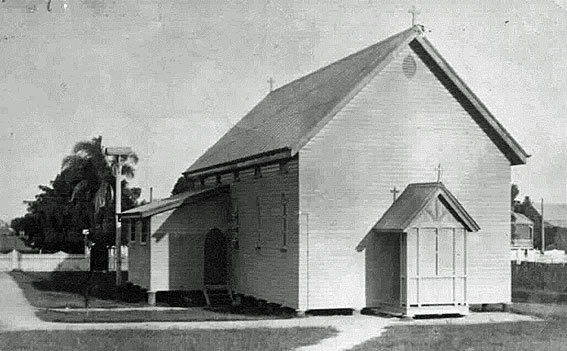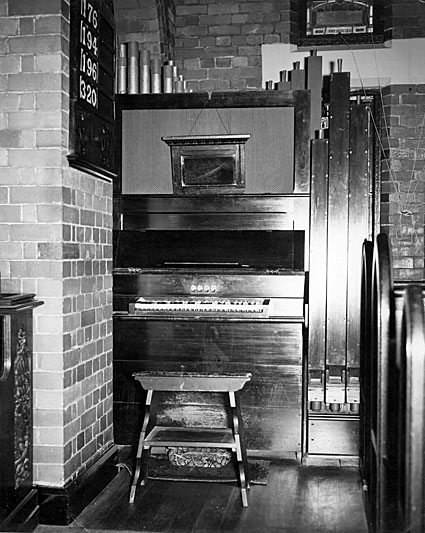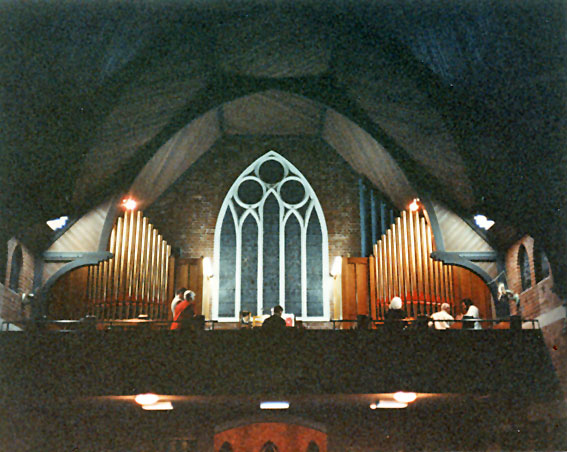St Augustine's Anglican Church
Charlton Street, Hamilton, Qld
FIRST ORGAN: B.B. Whitehouse & Co., Brisbane, 1918
Removed to St Margaret's Anglican Girls' School, Ascot 1958 Whitehouse Bros, Brisbane
PRESENT ORGAN: Whitehouse Bros, Brisbane, 1959
2 manuals, 15 speaking stops, electro-pneumatic action
Additions 1988; rebuilt & enlarged 2007 W.J. Simon Pierce, Brisbane
2 manuals, 19 speaking stops, electro-pneumatic action

St Augustine's Anglican Church, Hamilton
[Photograph by Howard Baker (1990s)]
Historical and Technical Documentation by Geoffrey Cox
© OHTA 2012, 2016 (last updated April 2016)
The first St Augustine's Church in the Brisbane suburb of Hamilton was opened and dedicated on 7 May 1896, having been designed by J.H. Buckeridge, the Anglican Diocesan Architect. This was one of about 60 wooden churches he designed throughout southern Queensland.

The first St Augustine's Church, Hamilton, in 1900
[Photograph from Anglican Diocese of Brisbane,
Records and Archive Centre, HAMIS063-14]
The foundation stone of the present war-memorial church was laid in December 1919 by Archbishop Donaldson. An imposing two-story brick building with a columbarium chapel on the lower level, it is noted for its stained-glass windows, including several by William Bustard (1894-1973). The building was opened on 17 October 1920, and dedicated on 17 April 1921. The architects were G.H.M Addison & Son. The elder G.H.M. Addison died in 1922, having formed 'G.H.M. Addison and Son' in 1919, when George junior joined him. His son continued the practice until 1928.
First Organ
The first organ at St Augustine's Church was built in 1918 by B.B. Whitehouse & Co. of Brisbane, and was installed initially in the old church. It was removed in June 1958 to the chapel at St Margaret's Anglican Girls' School, Ascot, and has subsequently been broken up.

The 1918 B.B. Whitehouse & Co. organ at St Augustine's Church, Hamilton
[Photograph from Anglican Diocese of Brisbane,
Records and Archive Centre, HAMIS063-95]
This organ was identical with one built by the same firm in 1919 for St Mark's Anglican Church, Albion.
Present Organ
The present organ was built in 1958-59 by Whitehouse Bros of Brisbane at a cost of £584. It was the gift of Colonel Dan Evans as a memorial to the Naval and Merchant Navy personnel who lost their lives in the Second World War, and was dedicated on 12 July 1959. The instrument is located in the rear gallery, and the choir stalls were moved from the chancel to the gallery when it was installed.
This was one of the larger electro-pneumatic Whitehouse organs of the period. As in others built by the firm at the time, the console fittings and electrical components were imported from Aug. Laukhuff of Weikersheim, W. Germany, and the metal pipes from Palmer of London. The instrument is contained in divided cases on either side of the west window, with the Swell and Pedal on the right, and the Great on the left.

The 1959 Whitehouse Bros organ in the gallery
at St Augustine's Anglican Church, Hamilton
[Photograph by Howard Baker (1990s)]
GREAT
- 8' Open Diapason
- 8' Stopped Diapason
- 8' Dulciana
- 4' Suabe Flute
- 4' Dulcet
SWELL
- 8' Violin Diapason
- 8' Lieblich Gedact
- 8' Echo Gamba
- 4' Gemshorn
- 2' Piccolo
- 8' Oboe
- 8' Cornopean
PEDAL
- 16' Open Bass
- 16' Bourdon
- 8' Bass Flute
COUPLERS
- Great to Pedal
- Swell to Pedal
- Swell to Great
- Swell Super to Great
- Swell Sub to Great
- Swell Super
- Swell Sub
Swell tremulant
Detached stop-key console
Electro-pneumatic action
Compass: 61/30
Balanced swell pedal
4 thumb pistons to Swell Organ
3 thumb pistons to Great Organ
Full Organ reversible thumb piston
Swell to Great reversible thumb piston
Great to Pedal reversible thumb piston.
Originally comprising 15 speaking stops, the specification was remarkably conservative for an organ built at this time. Lacking upperwork on the Great Organ beyond a Suabe Flute 4ft and Dulcet 4ft, it emulated closely the tonal design of organs such as that at St Joseph's Cathedral, Rockhampton (1925; 12 stops). The Swell specification, with the Piccolo 2ft as the highest flue stop, similarly showed no advance on the specification at the Methodist Church, West End (1923-24; 19 stops).
The original Dulcet 4ft on the Great Organ was removed in 1988, and two stops were added (Great Principal 4ft and Fifteenth 2ft) by W.J. Simon Pierce. The latter were 1909 Norman & Beard ranks that had initially been retained in the rebuilt organ of 1972 at St John's Cathedral, Brisbane, but were replaced there shortly afterwards.
An appeal was launched in 2003 for a comprehensive restoration of the organ, and proposals for further additions were developed by W.J. Simon Pierce. Between 2005 and 2007, Pierce undertook extensive rebuilding of the organ, including new action parts and a new blower. Three stops were added (Mixture II on the Swell; and Trumpet 8ft & Clarabella 8ft on the Great Organ). The Clarabella was a secondhand stop from the Great of the 1904 George Fincham and Son organ removed in the 1990s from the Grahame Memorial Uniting (Presbyterian) Church, Waverley, New South Wales. The original Stopped Diapason 8ft on the Great Organ became the Stopped Flute 4ft, and the original Suabe Flute 4ft became the Nazard 2-2/3ft. The wind pressure was generally lowered, and the two 1909 Norman & Beard ranks added in 1988 were returned to St John's Cathedral and replaced at St Augustine's by the corresponding Hill, Norman & Beard ranks (of smaller scale) dating from the 1970s at the Cathedral.
The rebuilt and enlarged organ was dedicated on 12 October 2007 with a recital by the Director of Music, Eduarda van Klinken. The current specification of 19 stops is as follows:
GREAT
- 8' Open Diapason
- 8' Clarabella [2007; Fincham and Son, 1904, ex Grahame Memorial Church, Waverley, New South Wales]
- 8' Dulciana
- 4' Principal [1988/1970s]
- 4' Stopped Flute [2007, formerly Stopped Diapason 8ft]
- 2-2/3' Nazard [2007, formerly Suabe Flute 4ft]
- 2' Fifteenth [1988/1970s]
- 8' Trumpet [2007]
SWELL
- 8' Violin Diapason
- 8' Echo Gamba
- 8' Lieblich Gedact
- 4' Gemshorn
- 2' Piccolo
- II Mixture [2007]
- 8' Cornopean
- 8' Oboe
PEDAL
- 16' Open Bass
- 16' Bourdon
- 8' Bass Flute
COUPLERS
- Great to Pedal
- Swell to Pedal
- Swell to Great
- Swell Super to Great
- Swell Sub to Great
- Swell Super Octave
- Swell Sub Octave
Swell tremulant
Detached stop-key console
Electro-pneumatic action
Compass: 61/30
Balanced swell pedal
4 thumb pistons to Swell Organ
3 thumb pistons to Great Organ
Full Organ reversible thumb piston
Swell to Great reversible thumb piston
Great to Pedal reversible thumb piston

[Photograph by Howard Baker (1990s)]